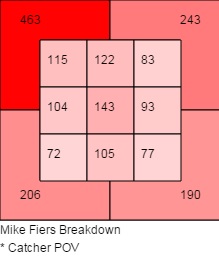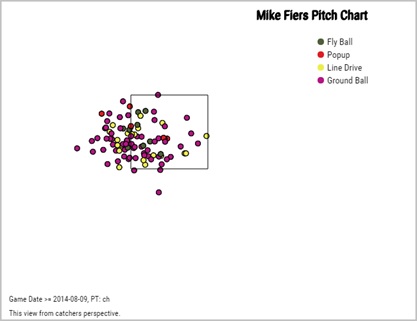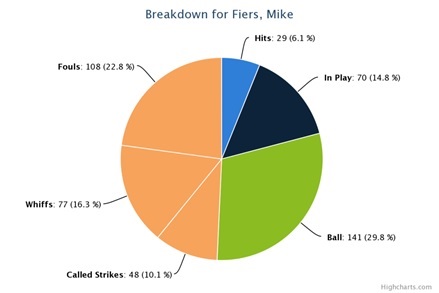This article is part of our Collette Calls series.
Even if you are just a casual historian, you are likely well aware of Abraham Lincoln's career record. Lost his first job, lost his first race, lost his first business venture, lost his first office, lost his second office, lost another race, and another, and then ended up with his face on Mt. Rushmore.
After Friday's 11,333-pitch no-hitter, Michael Fiers has his own improbable career timeline.
• Reaches the major leagues September 2011.
• Recalled to the majors May 2012, wins six of his first 12 starts with a 1.80 ERA and 80 strikeouts in 80 innings.
• Finishes 2012 losing six of his final 10 starts with a 6.99 ERA.
• Allows seven runs in his first seven innings of 2013 and is sent to Triple-A.
• Requests to be assigned to High-A in Florida so he can pitch in the minors while being closer to his gravely ill mother.
• Comes back to the big leagues in mid-May and is hit hard in a middle-relief role before his season was ended by a Kevin Kouzmanoff liner off his arm that broke it in two places.
• His mother dies of Lupus-related complications.
• Begins 2014 in Triple-A, goes 6-3 in 11 starts with a 2.53 ERA.
• Pitches seven innings of middle relief for Milwaukee before being sent back to Triple-A.
• Makes six more starts at Triple-A, holding batters to a .205 average with a 2.60 ERA.
• Finishes season with Milwaukee, winning six of his
Even if you are just a casual historian, you are likely well aware of Abraham Lincoln's career record. Lost his first job, lost his first race, lost his first business venture, lost his first office, lost his second office, lost another race, and another, and then ended up with his face on Mt. Rushmore.
After Friday's 11,333-pitch no-hitter, Michael Fiers has his own improbable career timeline.
• Reaches the major leagues September 2011.
• Recalled to the majors May 2012, wins six of his first 12 starts with a 1.80 ERA and 80 strikeouts in 80 innings.
• Finishes 2012 losing six of his final 10 starts with a 6.99 ERA.
• Allows seven runs in his first seven innings of 2013 and is sent to Triple-A.
• Requests to be assigned to High-A in Florida so he can pitch in the minors while being closer to his gravely ill mother.
• Comes back to the big leagues in mid-May and is hit hard in a middle-relief role before his season was ended by a Kevin Kouzmanoff liner off his arm that broke it in two places.
• His mother dies of Lupus-related complications.
• Begins 2014 in Triple-A, goes 6-3 in 11 starts with a 2.53 ERA.
• Pitches seven innings of middle relief for Milwaukee before being sent back to Triple-A.
• Makes six more starts at Triple-A, holding batters to a .205 average with a 2.60 ERA.
• Finishes season with Milwaukee, winning six of his 10 starts with a 2.09 ERA and holding batters to a .175 average.
• Goes 5-9 for Milwaukee with a 3.89 ERA, striking out 121 in 118 innings.
• Traded to Houston.
• Gets blasted in his Astros debut, allowing 10 baserunners and six earned runs in five innings.
• Doesn't earn a decision in his next two outings while holding the A's and Tigers at bay.
• No-hits the highest payroll in baseball.
Fiers is not blessed with the best velocity. Friday's improbable performance aside, Fiers has done some improbable things throughout his career despite the kind of velocity many look for from starting pitchers. We're talking about a pitcher who cracks 90 mph on a good day, but who has a swinging-strike rate better than the likes of Shelby Miller, A.J. Burnett, Jordan Zimmermann, Andrew Cashner and Nate Eovaldi -- all guys with better velocity. Fiers is old-school in that he is essentially a fastball, changeup, curveball pitcher that relies upon location, changing speeds and changing eye levels to get his work done.
The question is how?
Fiers is now 12-13 with a 3.15 ERA, a 1.15 WHIP and has struck out 25 percent of the batters he has faced in that time while holding them to a .225 batting average since being recalled from the minors last August. When we compare Fiers to all starting pitchers over the last year (dating to Aug. 9, 2014), we find he is in the top 25 for strikeout rate (25.3 percent), Opponents' batting average (.225) and Opponents' slugging percentage (.288), while just missing the cut with his ERA and WHIP. That strikeout rate puts him ahead of the likes of David Price, Cole Hamels, Felix Hernandez and Carlos Martinez, all guys with arguably much better stuff than Fiers. Again, how is he doing this? Let's break him down by pitch.
The fastball
It is not true that Fiers once had a fastball bounce off a pane of glass, but his fastball is what it is. The velocity is not as important as his location of it. It is a pitch he throws nearly 60 percent of the time, so his execution of the pitch is critical given the limitations of his velocity. As Fiers executes the pitch, he likes to locate it up.

Why does Fiers like to locate his "fastball" up there? It's all about Effective Velocity. I've talked about this theory a few times and if you would like to read about it in its long form, go read this excellent piece by Jason Turnbow. For now, watch this great video clip from Carlos Pena on MLB Network:
The beauty of the high fastball, when located properly and not pitching to Evan Gattis, is that it mitigates risk. After all, the league-wide batting average on flyballs this season is .149 while groundballs are .243 and line drives are .645. Most of the time, that high fastball is going to result in a flyball, which is one reason Fiers is able to keep his opponents' batting average so low. The high fastball also helps enhance his other pitches, such as the curveball.
The Curveball
Fiers has the rare 12-6 curveball in his bag of tricks, like Bert Blyleven threw in his day. It's not of the same pitch quality, but look at what it recently did to Shin-Soo Choo in a 1-2 count:
This season, opponents are hitting .141 against his curveball, which is third best in the league for pitchers throwing at least 200 curves. It is not normally a swing-and-miss pitch for him as his swinging-strike rate on the pitch is the league average for starting pitchers (12 percent) at 10 percent. What the pitch does do is help generate weaker contact as his batting average on curveballs put into play is 42 points below the league average for starting pitchers (.292) at .250.
The combination of the high fastballs and the 12-6 curveball work well together because batters are adjusting to the change in pitch type while the ball is in flight, and because of the depth of the pitch versus the horizontal movement of other curves, he gets weaker contact or swings and misses on this. Jason Castro brought this up Friday night after the game:
Notice Castro's comment about Brent Strom and the tunnel effect. If you haven't read the aforementioned article on Effective Velocity, Strom is cited:
"His fastball's only about 90," Castro said. "But he pitches up in the zone effectively. His curveball is such that it looks like his fastball, like an up-in-the-zone fastball. He gets a lot of swings on it and he's got pretty good depth on his curveball. So, I think kind of the play on those two pitches -- that tunnel effect that (pitching coach Brent) Strom talks about a lot -- he does that really well, and his changeup's one of his better pitches that he could throw to righties or lefties. So it's a third pitch that guys have to take into account."
"Strom met Husband at one of Wolforth's coaching clinics in 2004, and was quickly sold on EV's merits. Contrary to the sinker-heavy regimen employed by the Cardinals, of course, EV theory espouses keeping the ball up in the zone ... Strom taught the sinker as instructed, but also worked diligently to develop the wealth of power arms coming up through the system. Instead of forcing them all into the same low-ball mold of previous years, he taught the importance of adding velocity by emphasizing four-seam fastballs and keeping pitches up. As a result, the Cardinals, whose staff once was laden with sinkerballers, are barely recognizable. Shelby Miller: fastball guy. Lance Lynn: fastball guy. Michael Wacha: fastball guy. Trevor Rosenthal, Kevin Siegrist, Carlos Martinez: fastball guys, every one.
"The main thing for me is how much can be gained from pitching up in the zone, above the belt, and how the middle of the plate can be your friend," said Strom. "When Perry first said that to me, I looked at him funny, but it makes perfect sense. If you keep pitching to the edges of the plate and you end up walking people, you do more damage to yourself than if you'd just put the ball down the middle. Everybody thinks that middle-middle is such a bad place, but if you can buy a strike there, look at all the pitches you can throw off it -- cutters, sinkers, tailing fastballs, curveballs, changeups. It opens up everything. You just have to have the balls to do it." Fiers has certainly had the balls to do it. After all, it takes balls to pitch to the middle of the strike zone when you lack velocity. Other pitchers with similar stuff become nibblers that work the fringes of the zone, issue the walks when they miss, and three-run homers when they miss in the zone after that. His curveball generates groundballs at a 61-percent rate whereas the league average for starting pitchers is 52 percent.
The Changeup
When a pitcher lacks fastball velocity, a great changeup is one thing that can make the fastball better and Fiers has one. Look at this one he throws to Dexter Fowler earlier this season:
Fiers generates a high-frequency of groundballs with the pitch as he tends to fade it low and away to lefties.

Additionally, the outcomes when he throws the pitch are very favorable. He gets harmless strikes nearly 50 percent of the time on swings and misses, foul balls and called strikes. Only 21 percent are even put into play and just 6 percent have gone for hits this season (one home run).

Despite doing more with less just over the past calendar year, Fiers is still a bit of an enigma. Despite the high strikeout rate, the low batting average and the low on-base percentages, his other indicators don't line up. He doesn't have the overall swing and miss rates of other pitchers who do well in the K/BA/OBP triple slash. In short, Fiers will go as long as his command will take him. He has the sequencing and tunneling down, but if his command wavers just a bit, he will have issues. His margin for error is not the same as it is for other guys, but he has one of the original disciples of Effective Velocity as his pitching coach now and the two of them should work very well together.










